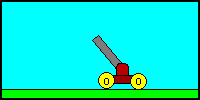motnewton.html
Newton`s Laws of Motion
Overview
In 1687, Sir Isaac Newton (1642-17270 published three laws, called Newton`s Laws of Motion, that addressed the following questions:
- What causes objects to start moving?
- Once objects are in motion, what keeps them moving?
 First Law - Inertia
First Law - Inertia
Newton`s first law of motion is the law of inertia. This law states that every object remains in a state of rest or uniform motion in a straight line unless acted upon by outside (unbalanced) forces. Inertia is a property of both moving and resting objects. Moving objects tend to stay in motion and resting objects tend to stay still. These tendencies are defined as inertia. It takes a force to cause a resting object to move, and it takes a force to stop a moving object. Inertia is the resistance to change. Once an object is set in motion it will continue to move until some other force is applied to make it stop. If an astronaut were to kick a ball while in deep space the ball would continue to go in a straight line. But if the ball was kicked on earth, the ball would be acted upon by the forces of air friction and gravity. It would eventually come back to the ground and stop. Another example of inertia is a person in a moving car. If the car is moving forward and the brakes are suddenly applied, the car will slow down and stop but the person will tend to continue to go forward. It tries to keep moving as before. Seat belts are worn to keep a person from hitting the windshield.
 Second Law - Acceleration
Second Law - Acceleration
Newton`s second law of motion states that if a force acts on an object, the object will move in the direction of that force. If the force is continually applied, the object will continually gain speed. This constant increase in speed is call acceleration. The stronger the force, the faster the object will accelerate. Consider two race cars that are identical except that one has a large engine and the other has a small engine. If these two cars were to race, which would accelerater faster and win the race? The one with the larger engine would win because it applies a greater force to the wheels.
Also massive objects are harder to accelerate than lighter objects. What if a very light car with a large engine was to enter? Would it win or lose the race? How would a light car with a smaller engine perform? Observe the above animation as observe the results of such a race.
In summary:
- An unbalanced force applied to an object will cause it to accelerate.
- The greater the force applied to an object, the greater the acceleration.
- Less massive objects are easier to accelerate than more massive objects.
 Third Law - Action/Reaction
Third Law - Action/Reaction
Newton`s third law of motion states that for every action, there is an equal and opposite reaction. This means that it is impossible to exert a force on an object without exerting a force in the opposite direction on some other object. When you jump off a bed, the force of your jump pushes the bed downward. When you hit a tennis ball, the strings vibrate or move from the force of the ball. And when a cannon ball is shot out of a cannon, the force that propelled the ball forward is matched with an equal force the moves the cannon in the opposite direction.
 First Law - Inertia
First Law - Inertia
 Second Law - Acceleration
Second Law - Acceleration
 Third Law - Action/Reaction
Third Law - Action/Reaction